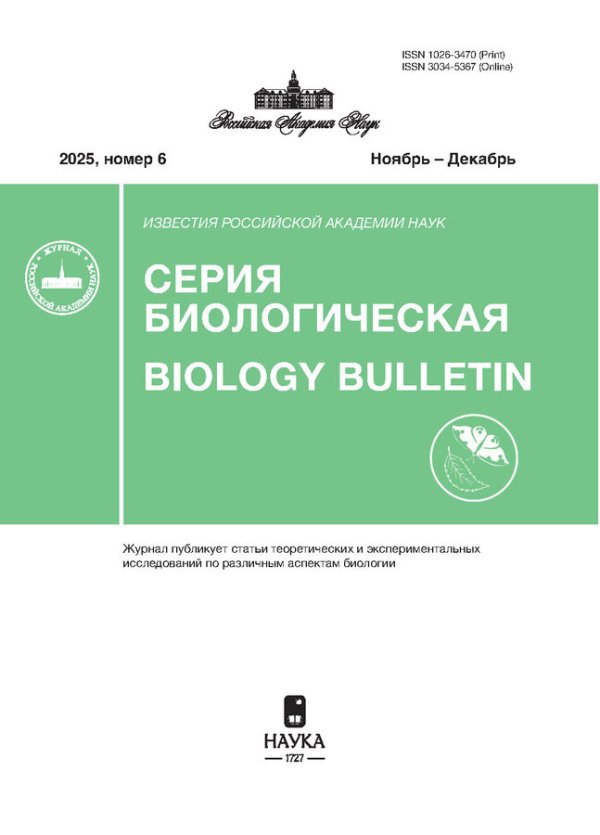Modeling Spatial Niches of Small Mammals Using the Example of Myodes glareolus in Mosaic Southern Taiga Forests
- Authors: Mikhalap S.G.1, Istomin A.V.2,3
-
Affiliations:
- Pskov branch of the Federal State Budgetary Institution “VNIRO”
- Pskov State University
- Central Forest State Reserve
- Issue: No 8 (2023)
- Pages: 42-51
- Section: ЭКОЛОГИЧЕСКОЕ МОДЕЛИРОВАНИЕ
- URL: https://journals.rcsi.science/1026-3470/article/view/231756
- DOI: https://doi.org/10.31857/S1026347023600875
- EDN: https://elibrary.ru/GPOJIO
- ID: 231756
Cite item
Full Text
Abstract
Based on long-term (2010–2014) studies carried out in the forest ecosystems of the Central Forest Biosphere Reserve, two models of the spatial niche of the bank vole (Myodes glareolus Schreber, 1780) were constructed using factor analysis (ENFA). Models with a sufficient level of quality characterize the characteristics of the species’ niche. The modeling results make it possible to describe the structure of the optimal habitat for the bank vole in mosaic southern taiga forests at different levels (scales) of spatial organization.
Keywords
About the authors
S. G. Mikhalap
Pskov branch of the Federal State Budgetary Institution “VNIRO”
Author for correspondence.
Email: smihalap@mail.ru
Russia, 180007, Pskov, st. M. Gorkogo, 13
A. V. Istomin
Pskov State University; Central Forest State Reserve
Email: smihalap@mail.ru
Russia, 180000, Pskov, pl. Lenina, 2; Russia, 172521, Nelidovsky district, Tver region, village. Zapovedny
References
- Ивантер Э.В. К популяционной организации политипического вида (на примере рыжей полевки – Clethrionomys glareolus Shreb) // Ученые записки Петрозаводского государственного университета. Сер.: Естественные и технические науки. 2008. № 1. С. 39–60.
- Истомин А.В. Климатические флуктуации и популяционная динамика ценозообразующих видов в эталонных лесных экосистемах Главного Русского водораздела // Вестник Псковского государственного педагогического университета. Серия естественные и физико-математические науки. Выпуск 2. Псков, 2007. С. 45–61.
- Истомин А.В. Мелкие млекопитающие в региональном экологическом мониторинге (на примере Каспийско-Балтийского водораздела). Псков, 2008. 278 с.
- Истомин А.В. Мелкие млекопитающие в биомониторинге лесных экосистем: комплексный подход // Вестник Тверского государственного университета. Серия “Биология и экология”. 2014. № 4. С. 95–113.
- Истомин А.В., Михалап С.Г. Градиентный подход и ГИС-анализ при изучении пространственной динамики популяций и сообществ организмов // Вестник Псковского государственного университета. Серия “Естественные и физико-математические науки”. № 1. Псков: Изд-во ПсковГУ, 2012. С. 49–55.
- Истомин А.В., Михалап С.Г. Использование “градиентных” ловушко-линий при изучении мелких млекопитающих в природных условиях // Материалы международной конференции. Актуальные проблемы охраны природы. Чебоксары. 2011. С. 6–7.
- Истомин А.В., Михалап С.Г. Картографическая модель пригодности местообитаний для красной полевки на территории Центрально-Лесного биосферного заповедника // Млекопитающие России: фаунистика и вопросы териогеографии, Ростов-на-Дону, 17–19 апреля 2019 года. Ростов-на-Дону: Общество с ограниченной ответственностью Товарищество научных изданий КМК, 2019. С. 97–100.
- Истомин А.В., Михалап С.Г. Анализ пространственной внутрипопуляционной организации мелких млекопитающих с использованием градиентного подхода и многомерного шкалирования // Принципы экологии. 2021. № 3. С. 42–53. https://doi.org/10.15393/j1.art.2021.11822
- Миркин Б.М. Современное состояние основных концепций науки о растительности / Б.М. Миркин, Л.Г. Наумова. Уфа: Гилем, 2012. 488 с.
- Огурцов С.С. Моделирование экологической ниши и пригодности местообитаний бурого медведя (Ursus arctos) в подзоне южной тайги с помощью метода факторного анализа GNESFA // Nature Conservation Research. Заповедная наука. 2020. Т. 5 (3). С. 86–113.
- Огурцов С.С., Михалап С.Г. Моделирование экологических ниш и пригодности местообитаний двух видов лесных полевок в условиях южной тайги // Russian Journal of Ecosystem Ecology. 2021. V. 6 (1). https://doi.org/10.21685/2500-0578-2021-1-4
- Пузаченко Ю.Г. Математические методы в экологических и географических исследованиях: учеб. пособие для студ. вузов, обучающихся по географии и экологич. специальностям. М.: Academia, 2004. 408 с.
- Пузаченко Ю.Г., Кузнецов Г.В. Экологическая дифференциация грызунов сезонновлажных лесов Южного Вьетнама // Зоол. журн. Т. 77. Вып. 1. 1998. С. 117–132.
- Пузаченко Ю.Г., Желтухин А.С., Козлов Д.Н., Кораблев Н.П., Федяева М.В., Пузаченко М.Ю., Сиунова Е.В. Центрально-Лесной государственный природный биосферный заповедник. Тверь. 2016.Печатня. 82 с.
- Шитиков В.К., Розенберг Г.С., Зинченко Т.Д. Экологические ниши, их современная интерпретация и перспективы моделирования. Самарская Лука: проблемы региональной и глобальной экологии. Т. 30 (4). 2021. С. 80–88.
- Шитиков В.К. Экологические ниши, их современная интерпретация и перспективы моделирования / В.К. Шитиков, Г.С. Розенберг, Т.Д. Зинченко // Самарская Лука: проблемы региональной и глобальной экологии. 2021. Т. 30. № 4. С. 80–88. EDN LZFJBP.https://doi.org/10.24412/2073-1035-2021-10427
- Austin M., Belbin L., Meyers J., Doherty M., Luoto M. Evaluation of statistical models used for predicting plant species distributions: role of artifcial data and theory. Ecological Modelling. 2006. V. 199. P. 197–216.
- Calenge C. Exploratory analysis of the habitat selection by the wildlife in R: the ‘adehabitatHS’ package. Saint Benoist, 2011. 60 p.
- Calenge C., Basille M. A general framework for the statistical exploration of the ecological niche // J. Theoretical Biology. 2008. V. 252. P. 674–685.
- Caruso N., Guerisoli M., Luengos Vidal E.M. et al. Modelling the ecological niche of an endangered population of Puma concolor: First application of the GNESFA method to an elusive carnivore // Ecological Modelling. 2015. V. 297. P. 11–19.
- Di Cola V., Broennimann O., Petitpierre B., Breiner F.T., D’Amen M., Randin C., Engler R., Pottier J., Pio D., Dubuis A., Pellissier R.G., Mateo R.G., Hordijk W., Salamin N., Guisan A. Ecospat: an R package to support spatial analyses and modeling of species niches and distributions // Ecography. 2017. V. 40. P. 1–14.
- Dormann C.F., Elith J., Bacher S. et al. Collinearity: a review of methods to deal with it and a simulation study evaluating their performance. Ecography. 2013. V. 36(1). P. 27–46.
- Fonderflick J., Azam C., Brochier C. et al. Testing the relevance of using spatial modeling to predict foraging habitat suitability around bat maternity: a case study in Mediterranean landscape // Biological Conservation. 2015. V. 192. P. 120–129.
- Galparsoro I., Borja Á., Bald J. et al. Predicting suitable habitat for the European lobster (Homarus gammarus) on the Basque continental shelf (Bay of Biscay), using Ecological-Niche Factor Analysis. Ecological Modelling. 2009. 220. P. 556–567.
- Guisan A., Thuiller W. Predicting Species Distribution: Offering More than Simple Habitat Models // Ecology Letters. 2005. V. 8. P. 993–1009.
- Guisan A., Zimmermann N.E. Predictive habitat distribution models in ecology // Ecological Modelling. 2000. V. 135. P. 147–186.
- Hirzel A.H., Hausser J., Chessel D., Perrin N. Ecological-niche factor analysis: how to compute habitat-suitability maps without absence data? Ecology. 2002. V. 83(7). P. 2027–2036.
- Hirzel A. H., Le Lay G., Helfer V. et al. Evaluating the ability of habitat suitability models to predict speciespresences // Ecological Modelling. 2006. V. 199. P. 142–152.
- Hutchinson G.E. “Concluding remarks”. Cold Spring Harbor Symposia on Quantitative Biology. 1957. V. 22 (2). P. 415–427.
- Istomin A.V., Mikhalap S.G. Simulation of spatial distribution of rare species in protected natural areas (on the example of the Central Forest Reserve, Russia) // Vide. Tehnologija. Resursi – Environment, Technology, Resources : Proceedings of the 12th International Scientific and Practical Conference, Rezekne, 20–22 июня 2019 года. V. 1. Rezekne: Rēzeknes Tehnoloģiju akadēmija, 2019. P. 75–77. https://doi.org/10.17770/etr2019vol1.4098.
- Nath A., Sinha A., Lahkar B.P., Brahma N. In search of Aliens: Factors influencing the distribution of Chromolaena odorata L. and Mikania micrantha Kunth in the Terai grasslands of Manas National Park, India // Ecological Engineering. 2019. V. 131. P. 16–26.
- Peterson A.T., Soberón J. Species Distribution Modeling and Ecological Niche Modeling: Getting the Concepts Right // Natureza & Conservação, 2012. V. 10(2). P. 102–107.
- Preau R., Trochet A., Bertrand R., Isselin-Nondedeu F. Modeling potential distributions of three european amphibian species comparing ENFA and MaxEnt // Herpetological Conservation and Biology. 2018. V. 13 (1). P. 91–104.
- Zimaroeva A.A., Zhukov A.V., Ponomarenko A.L., Matsyura A. Ecological niche modelling of Fringilla coelebs Linnaeus, 1758 (common chaffinch) using GIS tools // Romanian J. Biology. Zoology. 2015. V. 60 (2). P. 135–146.
Supplementary files













